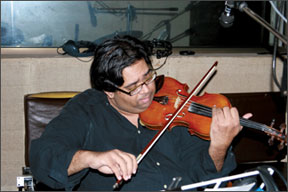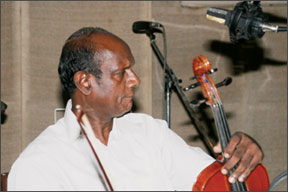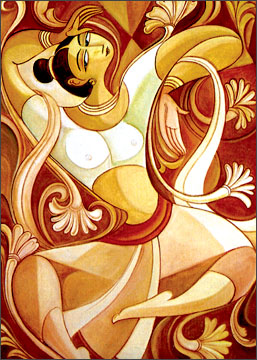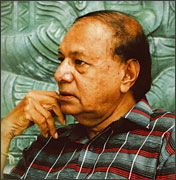arts
Poised to be a path definer;
Techno-excellence coupled with mastery in narration
Sadisi Tharanaya:
By Ranga Chandrarathne
|

Lukshman Joseph de Saram
|
With its application of techniques in cinema and the sharp-edged
editing, Sadisi Tharanaya, a tele-film by young and talented film maker
Devinda Kongahage would turn a new leaf in Sri Lanka’s tele-drama
industry.
Perhaps, it is the first time that cinematic properties of the medium
of television has been exploited to the maximum to drive home the truth
that television is capable of producing works of lasting value despite
its inherent limitations. Devinda in his attempt has effectively
by-passed the inherent barriers in the medium of television.
The tele-film is woven around a story of a murder where a powerful
Minister is involved. It seems that the Minister has himself planned and
executed the plot. At the day of murder, RDA Surveyor (Suresh Gamage)
with his still camera takes several shots of the murder and he sees
Minister (Sriyantha Mendis) who is in casual dress, fleeing from the
AGA’s residence. The next scene moves into a court room where a case is
filed against the Minister.
The RDA surveyor and Minister’s daughter (Damitha Abeyratne-Nirda)
testify against the Minister before the court. At the court, the RDA
officer is introduced as Senior Officer in the CID (Criminal
Investigative Department). From then onward, the story takes a different
direction going through diverse human and cultural landscapes.
It is here that young director Devinda commences conveying his no
Black-no-white-ash concept. A very important character in the tele-film,
the mother is played by Jayani Senanayake while the son’s character is
by Bimal Jayakody. Here Bimal has deviated from his usual approach of
slow-play characterization.
Remarkable collaboration
|

Amerasiri Pieris |
The very decision to commission maestro Premasiri Khemadasa to
compose music scores for the tele-film on the part of Devinda is
remarkable.
The divine touch of the mastero has not only uplifted the production
in terms of memorable scores of music which would etch in the minds of
the audience but also intensify the zest and appropriate moods as the
scenes unfold before the audience. The music scores are heart rendering
though different to those composed for cinematic jewels such as Thunveni
Yamaya, Nidhanaya, Ganga Addara, and Sagara Jalaya.
It is clear from the music scores, the omni-potent elements of
ensembled music has made them remarkable creations. Though it is for a
tele-film, Khemadasa’s composition of music will mark a milestone in his
career as he can by-pass the generation gap and reach out for deserving
audience.Music is new and of universal character which I would believe
will stand the test of the time.
Conceptualised the tele-film
The director conceived the idea for the tele-film on the day of
Tsunami and has been taken three years to complete the script. Given the
very nature of the concept-studded plot, it is no wonder that Devinda
has taken tree years to fine tune the plot meticulously blowing life to
the characters.
With a sharp perception and insight into the characters, Devinda
deals with the complex topics such as politics and media. Given the
nexus between politics and media, characterization and justification of
characters in the real world scenario would have been done taking into
consideration of viewers’ perspectives.
This aspect is amply demonstrated throughout the tele-film. For
instance, portrayal of principle characters such as Minister (Sriyantha
Mendis) and journalist (Damitha Abeyratne) have been masterly crafted
out of real world scenario.
The Director has completely failed to exercise control over
Shriyantha Mendis and Buddadasa Vithananaachchi’s over acting, at times.
Director should be commended for deriving the best performance out of
Bimal Jayakody, who depicted the role brilliantly. Here the credit
should be vested on the director who was able to get Damitha Abeyratne
to express complex emotions convincingly as did Enokaa Sathyagani in
‘Sulang kirilli’.
In terms of dialogues, Sadisi Saranaya will stand out among
contemporary productions in tele-dramas. I would rather say that
dialogues are extremely natural and it seems that Devinda has done
meticulous research into the nature of the characters.
Videography was by Prabhath Roshana and make up Wasatha
Vittachchi.Sadisi Tharanaya though edited in to 30 episodes, is a tele-film
given the extensive utilization of techniques of cinema for the
production. Devinda has taken an entirely innovative approach in the
production where the technical aspect and narrative is concerned.
Sadisi Tharanaya would be a film on television and give Sri Lankan
viewers a novel experience besides expanding the horizons in the media.
Narrative is enriched by inducing certain elements of non-linear
narrative style for the production.
Semage promotes Lankan culture in Japan
By R. S. Karunaratne
|

‘Dancer’
|
|

Kalasuri Jayasiri Semage
|
Internationally-renowned Kalasuri Jayasiri Semage will hold an
exhibition of his paintings in Tokyo, Japan shortly. The exhibition will
be a part of the cultural pageant organised by the Sri Lanka embassy in
Japan.
It will be held at the Yoyogi Park in Tokyo from September 13-14. The
Japanese and the Sri Lankan community in Japan will participate in the
cultural show highlighting Sri Lanka’s dances, singing and instrumental
music. The cultural pageant is open to the public.
Spectators at the cultural show will have the rare opportunity of
viewing some of the best paintings of Kalasuri Jayasiri Semage at one of
the stalls.
The exhibits will include paintings exhibited in several other
countries on previous occasions, a new painting entitled “New space” and
a few other paintings especially done for the current exhibition.
What is remarkable is that all the paintings will have Semage’s
inimitable Sri Lankan style. The paintings depict the undying beauty of
village scenes, rural environment and day-to-day activities of village
damsels. The 25-odd exhibits have been created using oil on canvas and
acrylic.
Semage has brought credit to Sri Lanka by exhibiting one of his
paintings permanently at the United Nation’s headquarters in Geneva,
Switzerland. He has also been honoured with the Presidential Award,
Kalasuri title and other titles such as Kalabhushana, Kalakeerthi and
Kalapathi. In addition, he has been conferred with the prestigious
“Sunfo” International Award for his services to the arts and culture.
The cultural pageant scheduled to be held at the Yogogi Park will
have a pandal designed by Kalasuri Jayasiri Semage. The pandal will
depict Sri Lanka’s indigenous cultural signs such as lions, “punkalas,”
swans and “liyavel” motiffs. It will be made in Sri Lanka and airlifted
to Japan ahead of the cultural show.
This will not be the first pandal erected by Kalasuri Jayasiri Semage
in Japan. He built a 60-foot high pandal when the Asia Pacific
exhibition was held in Fukuoka, Japan. The giant pandal depicted
Buddhist ideals in colourful paintings. The Japanese were so taken up by
his creativity that he was awarded a special certificate in appreciation
of his commitment to art.
Meanwhile, Kalasuri Jayasiri Semage has created history by erecting
colourful giant pandals for the Expo exhibitions held in many countries
of the world.
He also rendered a yeoman service by putting up pandals for “Gam
Udawa: and “Mahapola” national festival year after year during the
recent past.
His exhibition in Japan will be another landmark in his career. |
